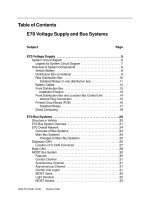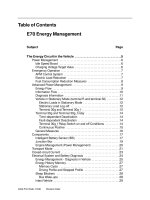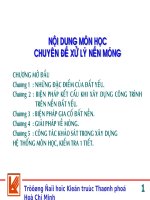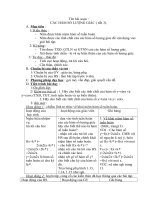C564 03
Bạn đang xem bản rút gọn của tài liệu. Xem và tải ngay bản đầy đủ của tài liệu tại đây (28.22 KB, 3 trang )
Endorsed by the
Cast Iron Soil Pipe Institute
Designation: C 564 – 03
Standard Specification for
Rubber Gaskets for Cast Iron Soil Pipe and Fittings1
This standard is issued under the fixed designation C 564; the number immediately following the designation indicates the year of
original adoption or, in the case of revision, the year of last revision. A number in parentheses indicates the year of last reapproval. A
superscript epsilon (e) indicates an editorial change since the last revision or reapproval.
This standard has been approved for use by agencies of the Department of Defense.
1. Scope
1.1 This specification covers preformed rubber gaskets used
to seal joints in cast iron soil pipe and fittings.
1.2 The values stated in SI units are to be regarded as the
standard. The values given in parentheses are for information
only.
1.3 The following safety hazards caveat pertains only to the
test methods section of this specification: This standard does
not purport to address all of the safety concerns, if any,
associated with its use. It is the responsibility of the user of this
standard to establish appropriate safety and health practices
and determine the applicability of regulatory limitations prior
to use.
1.4 The committee with jurisdiction over this standard is not
aware of another comparable standard for materials covered in
this standard.
2.2 Other Documents
RMA Class 3 Dimensional Tolerances, RMA Manual4
3. Terminology
3.1 Definitions—For definitions of terms in this standard see
Terminology C 717.
3.2 Definitions of Terms Specific to This Standard:
3.2.1 flash—the excess material protruding from the surface
of a molded article at the mold junction.
3.2.2 virgin rubber, n—a term that may be used interchangeably with raw rubber (raw thermoset elastomer). A
rubber or thermoset elastomer that has not had any additional
work, diluents incorporated, processes performed on it, or any
combination thereof. A rubber that is in an unmodified state or
one in which no attempt has been made to alter it in any fashion
as received from the manufacturer or supplier.
4. Materials and Manufacture
4.1 Gaskets shall be made of a properly vulcanized virgin
compound containing virgin rubber as the sole elastomer with
no scrap or reclaim.
2. Referenced Documents
2.1 ASTM Standards:
C 717 Terminology of Building Seals and Sealants2
D 395 Test Methods for Rubber Property—Compression
Set3
D 412 Test Methods for Vulcanized Rubber and Thermoplastic Rubbers and Thermoplastic Elastomers—Tension3
D 471 Test Method for Rubber Property—Effect of Liquids3
D 573 Test Method for Rubber—Deterioration in an Air
Oven3
D 624 Test Method for Tear Strength of Conventional
Vulcanized Rubber and Thermoplastic Elastomers3
D 1149 Test Method for Rubber Deterioration—Surface
Ozone Cracking in a Chamber3
D 1415 Test Method for Rubber Property—International
Hardness3
D 2240 Test Method for Rubber Property—Durometer
Hardness3
5. Physical Requirements
5.1 Sample gaskets selected as specified in Section 8 shall
conform to the requirements for physical properties listed in
Table 1 when tested in accordance with the methods specified
in Section 9.
6. Dimensions and Permissible Variations
6.1 Gaskets shall conform to the dimensions specified by
the manufacturer.
6.2 All cross-sectional dimensions shall have an RMA Class
3 tolerance as shown in Annex A1, and all diametral dimensions shall have a tolerance of 6 1 percent.
7. Workmanship
7.1 The surface of the gasket shall be smooth and free of
pitting, cracks, blisters, air marks, and any other imperfections
that will affect its behavior in service. The body of the gasket
shall be free of porosity and air pockets.
1
This specification is under the jurisdiction of ASTM Committee C24 on
Building Seals and Sealants and is the direct responsibility of Subcommittee C24.75
on Gaskets and Couplings for Plumbing and Sewer Piping.
Current edition approved Feb. 10, 2003. Published April 2003. Originally
approved in 1965. Last previous edition approved in 1997 as C564–97.
2
Annual Book of ASTM Standards, Vol 04.07.
3
Annual Book of ASTM Standards, Vol 09.01.
4
Rubber Manufacturer’s Association, 1400 K Street NW, No. 900, Washington,
DC 20005 – 2455.
Copyright © ASTM International, 100 Barr Harbor Drive, PO Box C700, West Conshohocken, PA 19428-2959, United States.
1
C 564 – 03
TABLE 1 Physical Requirements of Gaskets
Property
Hardness (nominal durometer 65) as specified by the
pipe manufacturer
Elongation, min, %
Tensile strength, min, MPa
(psi)
Tear strength, min, N/cm
(lbf/in.)
Compression set, max, %
Heat aging, 96 h at 70 6 1°C (158 6 2°F):
Hardness increase, max, durometer points
Loss in tensile strength, max,%
Loss in elongation, max, %
Water absorption:
Weight increase, max, %
Ozone resistance
Oil immersion:
Volume increase, max, %
Requirements
ASTM Test Method
50
60
70
D 2240
350
10
(1500)
268
(150)
25
300
10
(1500)
268
(150)
25
250
10
(1500)
268
(150)
25
D 412
D 412
10
15
20
10
15
20
10
15
20
20
no cracks
20
no cracks
20
no cracks
D 395
D 573
...
...
...
D 471
...
D 1149
80
80
80
D 471
D 624
9.6 Water Absorption—The gasket material shall be tested
for weight increase due to water absorption in accordance with
Test Method D 471. If a 25.4-mm (1-in.) specimen cannot be
cut from the sample gasket, the greatest width obtainable shall
be used. The test specimen shall be immersed in distilled water
at 70 6 1°C (158 6 2°F) for 7 days.
9.7 Ozone Resistance—The gasket material shall be tested
for ozone resistance in accordance with Test Method D 1149,
using specimens and procedure specified under Method B. The
ozone concentration shall be 150 parts/100 000 000 of air by
volume. Specimens shall be aged 100 6 1h at 40 6 1°C (104
6 2°F). A two-power hand magnifying glass shall be used to
examine the gasket for cracks.
9.8 Oil Immersion— The gasket material shall be tested for
volume decrease due to oil absorption in accordance with Test
Method D 471. If a 25.4 mm (1-in.) specimen cannot be cut
from the sample gasket, the greatest width obtainable shall be
used. The test specimen shall be immersed in IRM 903 for 70
6 0.7 h at 100 6 1°C (212 6 2°F).
7.2 Neither the flash thickness nor the flash extension shall
exceed 0.8 mm (1⁄32 in.), at any point on the sealing ring.
7.3 The offset, or failure of the mold to register accurately,
shall not exceed 0.4 mm (1⁄64 in.).
8. Sampling
8.1 For each of the tests, gaskets shall be selected at random
as required by the method of test specified.
9. Test Methods
9.1 Hardness—The gasket material shall be tested for
hardness in accordance with ASTM Test Method D 2240. Test
Method D 1415 shall be used as the referee method. Hardness
measurements shall be made on specimens prepared in accordance with 9.2. However, hardness readings for guidance
purposes shall be permitted to be taken directly on the gasket,
recognizing that these readings may vary slightly from those
taken on the dumb-bell specimens.
9.2 Elongation and Tensile Strength—The gasket material
shall be tested for elongation and tensile strength in accordance
with Test Methods D 412. Standard ASTM Type C dumb-bell
specimens conforming to Fig. 1 (Apparatus for Tensile Set
Test) of Test Methods D 412 shall be cut from a section of the
gasket for this test. To obtain a uniform thickness, these gasket
sections shall be permitted to be buffed prior to cutting into
dumb-bell specimens, so as to produce a finely ground surface
without cuts or burns.
9.3 Tear Strength— The gasket material shall be tested for
tear strength in accordance with Test Method D 624 using Die
C.
9.4 Compression Set— The gasket material shall be tested
for compression set in accordance with Test Methods D 395
using Method B. Specimens shall be aged in an oven for 22 h
at 70 6 1°C (158 6 2°F). Where plied specimens are
necessary, the results shall comply with the requirements of
Table 1.
9.5 Heat Aging—The gasket material shall be tested for
effects of heat aging in accordance with 9.2, and shall be aged
for 96 h at 70 6 1°C (158 6 2°F). Hardness measurements
shall be made as specified in 9.1.
10. Certification
10.1 When specified in the purchase order or contract, the
purchaser shall be furnished certification stating samples representing each lot have been tested and inspected as indicated
in this specification and the requirements have been met. When
specified in the purchase order or contract, a report of the test
results shall be furnished.
11. Marking
11.1 Mark each gasket with clearly legible letters not
exceeding 6.35 mm (1⁄4 in.) in height. These markings shall
include the gasket manufacturer’s name or symbol, the pipe
size and class (such as NH for no hub, SV for service, XH for
extra heavy), the year of manufacture, country of origin and the
ASTM specification designation.
12. Keywords
12.1 cast iron; fittings; gaskets; pipe; rubber
2
C 564 – 03
ANNEX
(Mandatory Information)
A1. RUBBER MANUFACTURERS ASSOCIATION, INC. TOLERANCES
See Table A1.1.
TABLE A1.1 RMA Class 3 Dimensional Tolerances (Commercial Tolerances)
Size, mm, (in.)
0 to 12.67 (0 to 0.499)
12.7 to 25.37 (0.500 to 0.999)
24.4 to 50.77 (1.000 to 1.999)
50.8 to 76.17 (2.000 to 2.999)
76.2 to 101.57 (3.000 to 3.999)
101.6 to 126.97 (4.000 to 4.999)
127.0 to 203.17 (5.000 to 7.999)
Greater than 203.2 (Greater than 8.000)
FixedA
ClosureB,C
60.254 (60.010)
60.254 (60.010)
60.381 (60.015)
60.508 (60.020)
60.635 (60.025)
60.762 (60.030)
60.889 (60.035)
multiply by
60.381 (60.015)
60.457 (60.018)
60.508 (60.020)
60.635 (60.025)
60.762 (60.030)
60.889 (60.035)
61.27 (60.050)
1.27 (0.0050)
A
Fixed dimensions are those that are parallel to the mold parting line or major mold sections and that are not affected by flash thickness variations. Tolerances apply
individually to each fixed dimension according to its own size.
B
Closure dimensions are those vertical to the mold parting line or parting lines of major sections and are affected by flash thickness variation.
C
The tolerance on closure dimensions is that tolerance for the largest closure dimension. This tolerance is then applied to all other closure dimensions.
ASTM International takes no position respecting the validity of any patent rights asserted in connection with any item mentioned
in this standard. Users of this standard are expressly advised that determination of the validity of any such patent rights, and the risk
of infringement of such rights, are entirely their own responsibility.
This standard is subject to revision at any time by the responsible technical committee and must be reviewed every five years and
if not revised, either reapproved or withdrawn. Your comments are invited either for revision of this standard or for additional standards
and should be addressed to ASTM International Headquarters. Your comments will receive careful consideration at a meeting of the
responsible technical committee, which you may attend. If you feel that your comments have not received a fair hearing you should
make your views known to the ASTM Committee on Standards, at the address shown below.
This standard is copyrighted by ASTM International, 100 Barr Harbor Drive, PO Box C700, West Conshohocken, PA 19428-2959,
United States. Individual reprints (single or multiple copies) of this standard may be obtained by contacting ASTM at the above
address or at 610-832-9585 (phone), 610-832-9555 (fax), or (e-mail); or through the ASTM website
(www.astm.org).
3





![MAKE magazine [OH] 03](https://media.store123doc.com/images/document/13/ce/fj/medium_fjg1388298702.jpg)



